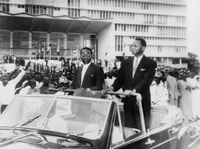On April 4, 1960, Senegal became independent, marking a significant milestone in African history that resonates deeply within the continent's collective memory. This date, etched in the annals of time, serves as a reminder of the aspirations and challenges faced during the tumultuous period of decolonization. However, Senegal's path to independence was not a solitary journey; it was intertwined with a broader vision embodied in the ill-fated Fédération du Mali, an ambitious project aimed at uniting the peoples of former French West Africa.
The aftermath of World War II saw France grappling with its colonial legacy and the pressures of global change. In 1946, it proposed the Union française, an arrangement that was more theoretical than practical. Yet, across Africa, a tide of resistance was rising. The quest for freedom was palpable, igniting a desire for self-determination among the colonies. Leaders such as Léopold Sédar Senghor and Modibo Keïta emerged as pivotal figures during this transformative time. Senghor, a poet and philosopher, and Keïta, a staunch advocate of Pan-Africanism, envisioned a united Africa, liberated from colonial shackles.
The formation of the Fédération du Mali on April 4, 1959, symbolized hope and unity. This federation brought together Senegal and the French Sudan (now Mali) with the intent to create a strong political entity capable of countering the fragmentation imposed by colonial rule. The founders aimed to transcend ethnic divisions and establish a Pan-African community, a nation of ideas rather than mere territorial claims. However, this ambitious vision required the approval of France, whose influence loomed large over the nascent federation.
As negotiations unfolded, General Charles de Gaulle's administration agreed to a gradual transfer of powers, allowing the federation to operate within the framework of the French Community. By March 1960, after protracted discussions, the Fédération du Mali secured agreements with France that would lead to independence, initially slated for June. Yet, beneath this seemingly optimistic surface, tensions were brewing.
Within the federation, two contrasting visions clashed. Modibo Keïta advocated for a centralized socialist state with Bamako at its helm, promoting rapid integration of the member states. In contrast, Senghor favored a more flexible association that respected the autonomy of its constituents. This ideological rift was not merely academic; it manifested in administrative confusion and financial ambiguities, undermining the federation's stability as the independence deadline approached.
On June 20, 1960, the Fédération du Mali celebrated its independence, becoming the first African entity to achieve sovereignty as a federation. It was a historic moment, yet fraught with underlying strife. As Keïta's government attempted to consolidate power, tensions escalated when he sought to dismiss Mamadou Dia, a prominent Senegalese politician and vice-president of the federation. This move was perceived in Dakar as a direct threat to Senegal's autonomy, leading to an open conflict.
By August 20, 1960, the situation reached a breaking point. The Senegalese National Assembly voted to withdraw from the federation, and Senghor declared Senegal's independence, expelling the Sudanese ministers from Dakar. Within days, the French Sudan rebranded itself as the Republic of Mali, marking the end of the federation and the dream of a unified West African state.
The disintegration of the Fédération du Mali represented more than just a political failure; it signaled the collapse of a collective vision for African unity and cooperation. As both nations retreated to their respective borders, they were left to navigate their individual paths, often influenced by the colonial divisions that had once been imposed upon them. Senegal, leveraging its political experience, embarked on a stable republican journey, while Mali, under Keïta, adopted a more radical approach that ultimately led to his downfall in a military coup in 1968.
As Senegal commemorates the 65th anniversary of its independence, the legacy of the Fédération du Mali remains a poignant reminder of the continent's enduring struggle for unity. It serves as a testament to the aspirations of a generation that sought to transcend colonial legacies and forge a new path for Africa. Today, the challenges of regional integration, shared sovereignty, and cooperative development echo the dreams of Senghor and Keïta.
The memory of the federation is not merely an account of failure; it embodies the potential for collective action and solidarity among African nations. The lessons drawn from this historical episode are more relevant than ever as the continent grapples with its identity and future. April 4 is not just a date marking Senegal's birth as a nation; it is a call to remember that independence is not an endpoint but a stepping stone towards a shared destiny.
In essence, Senegal was born twice on that day: as a sovereign state and as a symbol of a continent in search of unity and cooperation. The echoes of the past remind us that the journey towards true independence requires not only the establishment of nations but also the cultivation of connections that foster collaboration and mutual growth.






